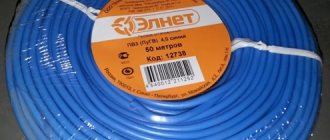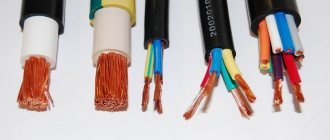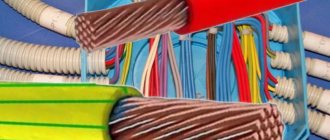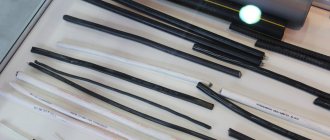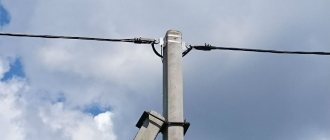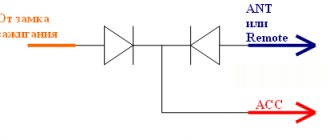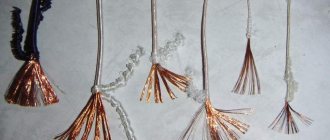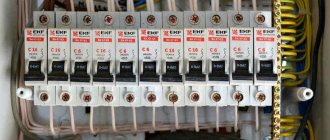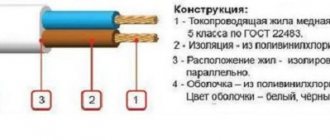Wire PV 3 (or PV-3) is an outdated, but still used designation for PuGV wire. Its characteristics and purpose are described in GOST 6323–79, adopted in the USSR. Currently, this state standard has been cancelled, and GOST R 53768–2010 has been introduced to replace it, but the wire itself has remained virtually unchanged - except that, thanks to new technologies, it has become more flexible. Now it is called PuGV.
What does marking mean?
Everything is simple here:
- The first letter in the alphanumeric index is the designation of the main type. "P" - wire.
- The second letter indicates that the wire has insulation (since there are also “bare” wires) and indicates its type. “B” is vinyl. Nowadays, polyvinyl chloride plastic with specific additives is used as a dielectric sheath for this and other wires, giving it additional properties - abrasion resistance, fire resistance, an unpleasant “chemical” odor (so that the wire is not chewed by mice and rats), and the like.
- The number 3 means flexibility class . In total there are (according to the old standard) 6 classes of flexibility. The higher the number, the more flexible the wire. This is the difference between PV-1 and PV-3 - the first is much less flexible.
The modern abbreviation stands for differently:
- Pu - installation wire;
- G - flexible;
- B - the insulation contains vinyl.
Note: previously wires were divided into installation and installation. According to modern GOST, the wire can only be used for installation, that is, used to connect electrical installations, but not used in installation work.
The last number is the number indicating the cross-section of the wire. The minimum cross-section is 0.5 mm.
Installation wire type PV 3 can have any color, but in modern realities it is usually produced in yellow-green insulation. The fact is that this conductor most often connects the “ground” in various electrical installations. However, the shell color can be any - black, grey, blue and even red.
Note: all of the above fully applies to the PV-1 wire. The whole difference between these two cables lies only in flexibility - PV-1 is much less flexible, since it uses a multi-wire conductor with a large cross-section of a single element - the wire itself.
Mark dimensions of wire PV3
- PV3 0.5
- PV3 0.75
- PV3 1.0
- PV3 1.2
- PV3 1.5
- PV3 2.0
- PV3 2.5
- PV3 3.0
- PV3 4.0
- PV3 5.0
- PV3 6.0
- PV3 8.0
- PV3 10
- PV3 16
- PV3 25
- PV3 35
- PV3 50
- PV3 70
- PV3 95
- PV3 120 *
- PV3 150 *
- PV3 185 *
- PV3 240 *
- PV3 300 *
- PV3 400 *
* Mark dimensions are not provided for in regulatory documentation.
Scope of application
The scope of application of PV-3, on the one hand, is quite broad, but on the other hand, it is very narrow. The whole point is that it is a single wire. It can, according to GOST, be used for electrical wiring, lighting, connecting various installations inside both residential and non-residential premises, but it is more convenient to carry out power installation with cables with two or more conductive cores - for single-phase and three-phase connections, respectively.
Therefore, at present, one of the main tasks of PV-3 (PuGV) is the grounding connection, where a single conductor is required. In some cases, they may connect the neutral. A bundle of several wires of different colors can be used instead of a common cable where flexibility is primarily required. It is also often used in the assembly of power cabinets, for connecting automatic machines, contactors and RCDs, in industry - where for some reason single conductors are required. In this case, the wire must be connected only using a crimp lug - pointed or in the form of a loop, since otherwise the wire may burn out.
It can also be used to create jumpers.
PV-3 has a voltage limitation - 450 V for alternating current or 1000 V for direct current. To connect powerful consumers, it is recommended to use it with caution, carefully selecting the appropriate cross-section.
When used, the cable must be placed in a corrugated pipe, cable duct or armored sheath. Laying in the ground or embedding into a wall is not allowed, since during excavation or repair and construction work it can easily be damaged or even cut down. The protective sheath of this type of conductor is designed to resist only minor mechanical stress.
Open installation with staples is permitted as a temporary measure, but nothing more.
It is not used outdoors, including the pulling method. Firstly, it is not self-supporting, and secondly, polyvinyl chloride gradually decomposes under the influence of direct sunlight.
If you have additional equipment, the wire can be used as a heating element - for heating frozen water pipes, and the like.
Its main advantage is lightness and flexibility. The minimum bend radius is 10 outer diameters, or exactly 90 degrees.
Note: modern PuGV has a higher flexibility class than its ancestor PV-3 - fifth.
This type of wire is moderately resistant to fire. When laid alone, it does not support combustion; in case of a short circuit, it melts, but does not spread fire. However, PV-3 is not fire-resistant wire and cannot be used in areas of increased explosion and fire hazard.
Mechanical properties
Determine the scope of application and operating conditions:
- Flexibility. A remarkable property that increases operational value and efficiency of use. The cross-section of each wire is the same, the number in the set determines the degree of flexibility. According to GOST 22483-77 for PV 3 wire, the wire diameter is 0.79 mm. For small cross-section cables, the wire diameter can be 0.53 mm and the minimum number of cores is 7, which corresponds to the fourth class of flexibility. The sum of the cut areas of the cores is the nominal cross-section of the cable, indicated in the technical specifications. The permissible bending radius is at least five outer diameters;
- Strength. The concept of the conductor design in the form of a cable provides, in addition to flexibility, increased mechanical strength and increases the ability to bear loads. The insulation material, which can be two-layer, can successfully withstand various mechanical influences without loss of useful properties and destruction. Linear tension until the moment of failure is 150% of the original length, that is, it lengthens one and a half times. The thickness of the insulation depends on the diameter of the core;
Nominal core cross-section, mmNominal insulation thickness, mm
| From 0.5 to 1.0 incl. | 0.6 |
| 1.5 | 0.7 |
| from 2.5 to 6 | 0.8 |
| 10.0 and 16.0 | 1.0 |
| 25.0 and 35.0 | 1.2 |
| 50.0 and 70.0 | 1.4 |
| 95.0 and 120.0 | 1.6 |
| 150 | 1.8 |
| 185 | 2.0 |
| 240 | 2.2 |
- Colors. Using the right color is very important and must comply with generally accepted standards. Creates convenience, reduces labor costs for dialing, troubleshooting for installers and repairmen, and promotes the creation of safe conditions for handling electricity. The colors are determined by the PUE and the European standard: o Yellow-green, yellow or green - intended for connection to the ground contact, the international designation of the contact is “PE”; o Blue or cyan connects the neutral, or “zero” (“N”); o The remaining colors are designated by “phase” (“L”) and are chosen arbitrarily.
In three-phase versions, it is customary to mark the phases:
- A – white;
- B – black;
- C – red.
DC circuits use different markings. Here white, black is “plus”, red is always, the rest are, as necessary, “minus”;
- Temperature. High electrical safety indicators are ensured by the presence of two layers of elastic insulation made of polyvinyl chloride modifier. Allows flawless operation in the ambient temperature range -50⁰С - +35⁰С, allowing long-term operation when the core is heated to +70⁰С. Installation, to prevent the formation of shell cracks, is prohibited when the air is cooled below -15⁰С.
Basic performance characteristics and design
The PV-3 cable has the following technical characteristics:
- construction length - 100 m;
- insulation resistance - 1 MOhm;
- conductor material - copper;
- minimum gasket temperature - minus 15 degrees Celsius;
- operating temperature range - from –50 to +35 degrees;
- maximum permissible humidity - 100% at a temperature of +35 degrees;
- standard service life is 15 years, warranty is 2 years.
Structurally, the PuGV is a single stranded conductor enclosed in a dielectric shell. GOST allows that this wire can be single-core, but in practice you will not find this, since the single-core design deprives the cable of its main advantage - flexibility. Therefore, the norm is a multi-core design with a number of wires of at least 7. The smaller the wire diameter, the better the flexibility. So, for class 3, copper wire with a diameter of up to 0.79 mm is used, if the total cross-section does not reach 50 mm. As the cross-sectional diameter increases, the number of wire strands also increases.
Please note: when purchasing a PV-3 wire, it is recommended to measure its diameter D with a caliper (the cross-sectional area can then be calculated using the formula S = 0.785 × D² ), since many unscrupulous manufacturers tend to save copper by underestimating this extremely important parameter.
The maximum diameter of the PV-3 wire can be 95 mm.
Specifications
All characteristics of PV3 can be conditionally divided into mechanical, thermal and electrical, which determine its ability to fully solve the assigned tasks. Check them all out:
- Permissible wire bending radius – determines by what amount, depending on the parameters of the brand, a given conductor can be bent. This parameter is checked immediately after production and entered into the product passport. For PV3, the radius ratio is observed when laying at least 5 diameters of the outer part of the wire itself.
Rice. 4: bend radius - Permissible mechanical elongation of insulation - characterizes the ability of the polyvinyl chloride layer to change its geometric parameters, but not less than 50% of the existing length. So that the wire can be easily bent within a given range.
- Operating temperature is the permissible temperature limit at which normal operation of the wire is allowed without loss of its declared parameters. In relation to this brand, the nominal limits range from – 50°C to +70°C.
- Short-term overheating - exposure is allowed in an emergency or when the system is overloaded up to 150°C. At the same time, the insulation maintains dielectric and mechanical parameters.
- Resistance of the insulating layer to single impacts , acoustic and vibration influences. Due to its narrow specialization, such characteristics of PV3 are not relevant for the average consumer; they are important for communication lines and specific equipment.
- Electrical insulation resistance is tested at the manufacturing stage by immersing the wire in water and then applying a voltage of 2.5 kV for 5 minutes.
- Conductivity of the core is determined by the resistance of the copper conductor; this value is standardized for each brand separately and can vary depending on the temperature of the wire.
Table: dependence of PV-3 parameters on the number of wires and their cross-section.
| Nominal cross-section (mm2) | Minimum number of wires in the core (pcs) | Wire outer diameter (mm) | Maximum electrical resistance of the core at direct current and temperature 20°C. (MOhm/km) |
| 0,5 | 7 | 2,0 | 39,6 |
| 0,75 | 7 | 2,2 | 25,5 |
| 1,0 | 7 | 2,3 | 21,8 |
| 1,5 | 7 | 2,8 | 14,0 |
| 2,0 | 15 | 3,1 | 9,97 |
| 2,5 | 19 | 3,5 | 8,05 |
| 4,0 | 19 | 4 | 4,89 |
| 6,0 | 19 | 4,6 | 3,11 |
| 10 | 49 | 6,3 | 2,0 |
| 16 | 49 | 7,5 | 1,21 |
| 25 | 77 | 9,9 | 0,809 |
| 35 | 105 | 10,9 | 0,551 |
| 50 | 144 | 13,3 | 0,394 |
| 70 | 210 | 15,5 | 0,277 |
| 95 | 285 | 17,6 | 0,203 |
| 120 | 360 | 19,5 | 0,162 |
| 150 | 444 | 21,2 | 0,129 |
| 185 | 555 | 23,8 | 0,104 |
| 240 | 760 | 27,1 | 0,0808 |
It should be noted that despite the lower operating temperature limit of – 50°C, it is allowed to lay the wire in conditions not lower than – 15°C, since the insulation becomes fragile and can be easily damaged when bent. If you need to lay PV3 in a cold climate below – 15°C, it needs to be additionally heated.
Check upon purchase
It is recommended to check the PV-3 cable very carefully before purchasing, since the market is flooded with a large number of fakes, characterized at best by an undersized cross-section, and at worst by a complete non-compliance with the stated requirements, primarily in terms of safety.
- It is always recommended to take products that are labeled with the wording GOST, and not TU. A cable made according to specifications is not formally considered a fake, but the fact is that each manufacturer determines the “technical conditions” for himself.
- A label should always be stuck on the bay, and alphanumeric markings should be applied to the insulation in a certain increment (about half a meter).
- Check the cross-section with a caliper you take with you.
- Request from the seller documents that the wire has passed the conductor resistance test, the insulation breakdown test, and the voltage test.
In addition, periodically during operation the cable must undergo “running tests”.
Electrical parameters
The basic values of quality characteristics sufficient for practical use are the electrical insulation strength and the resistance of the conductive copper core, standardized by GOST to one kilometer of length. The values are presented in the table.
Number of cores X cross-section, mm 2 External diameter (size), mm. Wire weight, kg/km. Diameter of the conductor, mm. Maximum electrical resistance to direct current of the conductor (at +20°C), Ohm/km. Electrical resistance of wire insulation, kOhm/km, not less (at +70°C)
| 1×0,75 | 2.31 | 11.4 | 1.11 | 24.5 | 11 |
| 1×1,0 | 2.46 | 13.8 | 1.26 | 18.1 | 10 |
| 1×1,5 | 2.96 | 20.6 | 1.56 | 12.1 | 10 |
| 1×2,5 | 3.7 | 34.3 | 2.1 | 7.41 | 9 |
| 1×4,0 | 4.2 | 49.4 | 2.6 | 4.61 | 7 |
| 1×6,0 | 4.8 | 70.6 | 3.2 | 3.08 | 6 |
| 1×10,0 | 6 | 110 | 4 | 1.83 | 5.6 |
| 1×16,0 | 7.8 | 184 | 5.8 | 1.21 | 4.6 |
| 1×25,0 | 9.6 | 285 | 7.2 | 0.809 | 4.4 |
| 1×35,0 | 11.4 | 401 | 9 | 0.551 | 3.8 |
It can be seen that with an increase in the nominal cross-section, the maximum current resistance decreases, the permissible current load and the maximum connected load power increase. The physics of operation of alternating current circuits is manifested by mutual interference of the electromagnetic field. It is important to consider the number of wires in a joint installation. The table illustrates this. PV 1, shown in the table, differs from PV 3 in the presence of a single solid core rather than a twisted one, that is, only flexibility.
The electrical strength of PV 3 is guaranteed to allow successful operation in alternating current (frequency up to 400 Hz) and direct current networks up to 1000 volts inclusive. Insulation testing is carried out with an increased voltage of 2500V.
The section ends with a summary table of the main technical characteristics of PV 3. The data given in it is sufficient for practical use:
| Air humidity at 35 0 C [%] | 100 |
| Warranty period [month] | 24 |
| Test AC voltage 50 Hz for 15 min. After staying in water for 24 hours [B] | 2500 |
| Maximum operating temperature of the core [0 C] | 70 |
| Rated voltage U0/U [V] | -15 |
| Bending radius of cables [outer diameters] | 450/750 |
| Construction length, not less [m] | 10 |
| Ambient temperature, upper limit [0C] | 100 |
| Ambient temperature, lower limit [0 C] | +35 |
| Electrical insulation resistance, not less than [Mom*km] | -50 |
| 1.0 |
Selection, nuances of choice
Before purchasing the wire necessary for the work, you need to calculate the required cross-section of the core taking into account the load. Careful calculation requires special knowledge and the ability to apply data from the tables “Rules for the construction of electrical installations” (PUE). For a non-professional, it is enough to know that a lighting network in a room requires 1.0 - 1.5 mm² of copper wire cross-section. Connection of sockets – 1.5 – 2.5 mm², electric boilers, stoves and air conditioners – 4.0. The entrance to a standard apartment is made with a cross-section of 6.0 mm². Having decided on the layout and wiring route for the facility, the total length of the wire of each required cross-section is calculated. A margin of size is needed, but the price range greatly depends on the diameter of the wire, so you should not include 6.0 mm² in the layout where 1.5 is enough.
Having completed the calculations, you need to start purchasing materials. The characteristics of the PV 3 wire comply with the requirements of GOST 6323-79, which standardize the material, the nominal cross-section of the core, and the thickness of the insulation. If there is no permanent, trustworthy supplier, the wire will be purchased randomly, wherever necessary. To protect your purchase from an dishonest seller, without trusting the markings, having a caliper is enough. The conductor diameter and insulation thickness are known from the technical specifications.
Important:
- Insulation. It can be single or double layer, in which case the first makes up at least 70% of the total thickness. The plastic should separate from the conductor easily enough without causing visible damage to the copper surface. The presence of dents, swellings and other irregularities is unacceptable.
- Lived. A fresh cut of the core will help you see the “correctness” of the material; you can find copper-plated aluminum at the price of copper. Irregularities, dark spots, non-copper color of the cut are a sign of poor quality copper. Real copper does not spring back when bent and can withstand at least 30 bends (high-quality aluminum will break after 8-10 times).
A way to identify low-quality goods
Prohibited products have many disadvantages: lack of marking with information about the conductor, inconsistency of technical parameters for use, and many others.
In order not to unfoundedly declare that all wires of this brand are unsuitable (since there are products that meet electrical safety requirements), experts recommend checking this fact experimentally.
When buying a cable, you must first measure the thickness of the conductor with a micrometer. To do this, the core is clamped between the measuring plates. The actual size can be seen on the instrument display. Such measurements will certainly help you avoid purchasing low-quality products.
Explanation of symbols
To understand the scope of application of each specific wire, you must be able to read the markings. In this case it reads like this:
- P. – respectively wire.
- U. - installation.
- V. – insulation material (vinyl).
At the beginning of the marking there is no letter “A”, which indicates the metal used in the manufacture of the wire. In this case it is copper. The numbers following the letters indicate the cross-sectional size of the current-carrying conductor. For example, PUV 3.5 - the cross-sectional size is three square millimeters.
